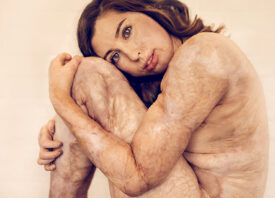Search this site
12 Must-See Exhibitions at the Indian Photography Festival

Delhi, India © Alejandra Cardenas, from The Print Swap by Feature Shoot
The Indian Photography Festival (IPF) by the Light Craft Foundation is now underway! As South Asia’s leading photography festival, IPF 2018 includes stunning exhibitions, talks, workshops, and portfolio reviews with some of the world’s most influential and pioneering artists, journalists, and editors. Among those present are the photojournalists Nick Ut (Vietnam) and Anush Babajanyan (Armenia), National Geographic‘s senior photo editor James Wellford, the photographer Sandro Miller, the photographer/filmmaker Pep Bonet, and many more.
Featuring 550 photographers hailing from 52 countries, this year’s events speak to the power of photography to inspire social change. Exhibiting organizations range from Women Photograph to the Siena International Photo Award and everyone in between. The festival opened last night at the State Gallery of Art in Hyderabad, India, and it will run through October 7th. In anticipation of opening weekend, we put together this preview of just twelve of this year’s extraordinay exhibitions to whet your appetite. Be sure to head on over the IPF website to see the whole schedule. And if you’re in or near Hyderabad this month, don’t miss the chance to see all the shows in person!

A sadhu smokes marijuana on a chillum (pipe). Pushkar, India. 2017. © Yuri Andries
The Print Swap by Feature Shoot 25 images from our worldwide project The Print Swap are on view at IPF in an exhibition curated by the influential photojournalist Ami Vitale. Featuring photographers living in India, the United States, Mexico, Peru, Argentina, Brazil, Costa Rica, Italy, Switzerland, Belgium, Estonia, Indonesia, and Australia, this collection transcends political and geographical boundaries, bringing together images that directly and indirectly speak to humankind’s capacity for curiosity and empathy. You can see all exhibiting images and learn more about the exhibition here. As always, photographers can submit to The Print Swap by tagging #theprintswap on Instagram. If selected, participating photographers give a print and receive a print from another artist somewhere in the world. Find details here.

Vietnamese refugee family escaping An Loc, South Vietnam on Highway 13, during Viet Cong takeover, 1973 © Nick Ut
Vietnam War by Nick Ut Today, Kim Phuc and Nick Ut are friends. In 1972, she was a 9-year-old girl living in Trang Bang, a village 25 miles outside Saigon, and he was a photojournalist with the Associated Press. They met when she and a group of other children fled their homes during a napalm bombing. Ut took Kim to the hospital, where it was determined she had suffered third degree burns over a significant portion of her body; his actions ultimately saved the young child’s life. ‘The Terror of War’, Ut’s iconic photograph of Kim, immortalized the events of that day, and nearly half a century later, Ut’s documentation of the Vietnam War remains a powerful and much-needed reminder of the cost of conflict and the importance of preserving our humanity. Last night at IPF, Nick Ut spoke with Mark Edward Harris to inaugurate the festival.

© Robin Schwartz
Amelia and the Animals by Robin Schwartz For thirteen years, the photographer Robin Schwartz has collaborated with her daughter Amelia and the animals in their lives to create poetic, fantastical images. Though the photographs themselves evoke themes from mythology and folktales, they speak to the value of real, individual creatures and the connections that form between us. “I am driven to depict our relationships with animals in the hope that these moments portray the sameness of humans and animals,” Schwartz writes. “My daughter and I share affinity with the animal kingdom that unites us to create photographs that tangibly access our dreams and discover the extraordinary.”

AL HUDAYDAH, YEMEN – 19 APRIL 2017. A dead cow lies beside the main road leading out of the port town of Al Hudaydah. Locals tend to avoid dead carcasses as some have been known to be filled with Improvised Explosive Devices (IED). © Giles Clarke
Yemen in Crisis by Giles Clarke In Yemen, the photojournalist Giles Clarke documents what has been called the “worst humanitarian crisis in the world.” After three years of civil war, estimates say more than 13,000 civilians have been killed. The threats of starvation and cholera loom large over millions of people, many of them children. “During the spring of 2017, I was granted rare access into the Houthi-held rebel area to document the insufferable and protracted crisis,” Clarke writes. “Without a complete cessation of hostilities, a solid lasting peace plan and guaranteed ongoing humanitarian access, the future for the civilians of the Middle East’s poorest country is certainly one of growing desperation and prolonged human suffering.”

© Sara Bennett
Life After Life in Prison: The Bedroom Project by Sara Bennett In addition to her work as a photographer, Sara Bennett is also a public defender, so she understands the problem of mass incarceration from the inside out. Here, she shares portraits and stories from women who, after being convicted of serious crimes, have served between fourteen and thirty-five years behind bars in maximum security facilities. “These women were open and trusting enough to allow me into their most private spaces — their bedrooms — and to share the comments that accompany the photos,” Bennett writes. “Like me, they hope this work will shed light on the pointlessness of extremely long sentences and arbitrary parole denials, and thus help their friends still in prison: women (and men) like them who deserve a chance at freedom.”

© Sharbendu De
Imagined Homeland by Sharbendu De Very few members of the media have traveled to the forests of Arunachal Pradesh, India, to tell the stories of the Lisu tribe, an isolated community of people who, for decades, have been denied access to basic human rights like healthcare and education. Sharbendu De is one of those few. He’s risked his own safety to travel to these forests and amplify the voices of the Lisu people, many of whom have become his friends. Instead of taking a traditional documentary approach, De choses to stage poetic, magical realist images that tap into Lisu mythology and the tribe’s connection with nature. Read our full story on the Imagined Homeland project here.

© Gilles Nicolet
Six degrees south by Gilles Nicolet For years, Gilles Nicolet has used his camera to document the relationship between man and nature and to preserve the memories of disappearing communities or traditions. With Six degrees of south, a body of work made over two years along the Zanzibar, Mozambique, Kenya, and Tanzania coasts, he does both. “For a thousand years now, wooden dhows and their characteristic white cotton sails have sailed these lonely shores, using the monsoon winds to help traders move goods between Africa and Arabia,” Nicolet writes. “But years of rich tradition and culture are on the brink of change. The emergence of large cities such as Dar es Salaam and Mombasa, the development of massive harbours to serve the interior of Africa, and the recent discovery of huge gas fields in the region are all threatening this ancient way of life. With this recent work, I have tried to testify to the unique beauty of this culture and to record it for generations to come.”

Juanita, a resident of Casa Xochiquetzal, takes a shower at the shelter in Mexico City, Mexico on September 3, 2013. Casa Xochiquetzal is a shelter for elderly sex workers in Mexico City. It offers its residents refuge, food, health services and a place to learn about their human rights, as well as courses to help them rediscover their self-confidence and deal with traumatic aspects of their lives. Casa Xochiquetzal provides a space to age with dignity for a group of vulnerable women who are often invisible to society at large. It is the only such shelter in existence in Latin America. © Benedicte Desrus
The Women of Casa Xochiquetzal by Benedicte Desrus “For the past 10 years, I documented the day-to-day lives of the women living at Casa Xochiquetzal, a unique shelter for elderly sex workers in Mexico City,” the photojournalist Benedicte Desrus writes. In this book and exhibition project, she shares slices of daily life in this safe haven for women, where residents have access to housing, meals, medical care, human rights education, and a sense of community. You can read our full story on Desrus’s longterm project here.

© Sina Niemeyer
„Fur mich.“ by Sina Niemeyer The photojournalist Sina Niemeyer delves into her own past as a survivor of sexual abuse, using photography, words, and found and altered family photographs to tell a story that is both deeply personal and startlingly universal. “With photography as therapy, the book itself is meant to serve as a tool for social change,” the team at Ceiba Editions writes of the resulting book, available here. By honestly and evocatively addressing her history, one shared by children and adults around the world, Niemeyer asks us to address a difficult topic with both courage and compassion.

African elephants gathered to feed on loose soil for it’s minerals – remote camera perspective (Loxodonta africana). Maasai Mara National Reserve, Kenya. Dec 2012. © Anup Shah
The Mara by Anup Shah “I wanted to impart to the viewer what it feels like – mentally and physically – to be inside the vast and lively landscape of Maasai Mara,” the photographer Anup Shah writes. As the child of two Indian parents, Shah was born in Kenya, where the landscape and its wild inhabitants helped inspire the photographer’s enduring passion for nature. At a time where many of these animals face endangerment due to human activity, his breathtaking and intimate encounters with the extraordinary animals of the Mara speaks to our connection with the earth. Shah continues, “I hope the viewers can open up to Mara and its animals – feel the earth, smell the wind, touch the elephant’s wrinkled skin, and come face to face with their personalities and presence.”

Brothers Micha from Jakarta and Misi from Makassar embrace their parents, father Tumaang and mother Rara. The grave house is located on top of a hill overlooking the rice fields. © Alain Schroeder
Living for Death by Alain Schroeder The Belgian photojournalist Alain Schroeder teaches us about the rituals surrounding death and grief in Toraja Land, Indonesia, where families can spend months preparing for the funeral of a loved one. “During this time, the deceased is considered to be ‘sick’ and kept at home,” Schroeder writes. “While, it remains a sad time, the transition from life to death is a slow and peaceful process strengthening family bonds.” For Ma’ Nene, a ceremony sometimes called a “second funeral” or “cleaning of the corpses ceremony,” family members revisit the dead. “During Ma’ Nene, coffins are opened, mummies are cleaned and given new clothes,” the photojournalist continues. “Expressions of sadness are mixed with happiness in these moments of bonding with loved ones and honoring ancestors.”

Julian Rodriguez plays with his son Christopher at their home on Pueblo’s East Side. Julian’s decades-long struggle with addiction brought him intimately close to the gang operations as he often bought from and sold for the gangs in order to support his own addiction. With his son, Christopher, on the way, he reached sobriety and had his facial skeleton tattooed to remember his commitment to his son and to commemorate his brother “Bone Head” who was killed in a shootout with the police. “Everything that I desire and want in this life is for that boy,” he explains. Christopher will grow up on the East Side, deep in Duke territory, but Julian hopes that a loving relationship with his father can keep him away from that lifestyle. © Gabriel Scarlett
Flock of Doves by Gabriel Scarlett Approximately one percent of the population of Pueblo, Colorado is part of a gang. Gabriel Scarlett reveals the individual stories behind the statistics, weaving together a complex narrative about youth, family, and a yearning to belong. “What is often lost in this narrative of gang violence is a community of voices demanding change,” the photojournalist writes. “Frontline churches welcome gang members, addicts, and dealers while former gang bangers have begun to mentor the youth and steer them away from repeating their pasts. Mothers and fathers who raise babies in gang territory speak of a sacrificial love that they must model for their children who are recruited by the gangs as early as 10 and 11. These images are of and for them.”



